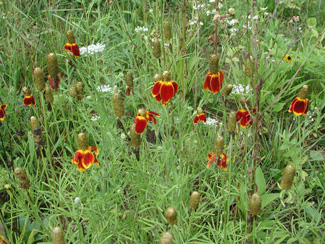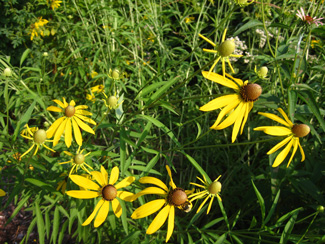Resource Library
Plant of the Week: Coneflower, Mexican Hat

Plant of the Week
Coneflower, Mexican Hat
Latin: Ratipida
Though I've known the wildflower Mexican Hat (Ratibida columnaris) since my childhood growing up on a dryland farm in central Oklahoma, I haven’t thought of it until recently when I read Michael McGarrity’s 1997 book Mexican Hat on my iPad.
Due to the magic of e-books it is now incredibly easy and addictive to read all manner of novels even though they have long been out of print. My latest addiction is reading books in the vein of the Tony Hillerman mystery series based in the Rocky Mountain west. Authors such as McGarrity, Craig Johnson and C. J. Box spin tales where the landscape itself becomes one of the main characters in their novels.
There are seven species of Ratibida described with all of them native to North America, but only four are found in the United States. They are summer blooming perennial herbs of the daisy family. Two are commonly grown in gardens, the aforementioned Mexican Hat and the Gray-head or Drooping Coneflower (Ratibida pinnata).

The two species are easily differentiated with Mexican hat (R. columnaris)being smaller (about 2 feet tall) with finely dissected leaves that are mostly on the lower half of the plant. It has fibrous roots and, though it is perennial and doesn't flower until the second year after seeds are planted, it tends to be short lived in the garden.
The 2-inch wide flowers are typical of the daisy family except that the center portion of the flower where the mass of brown disk florets is borne is much extended and can stretch to 2 inches in length. The drooping ray petals are usually in shades of reddish-brown with varying widths of yellow banding near the end. Plants bloom from early summer until early fall but never completely covering the plant, instead creating an ongoing sprinkling of color. Though this species is primarily centered in the drier parts of the prairie states it is found almost everywhere except the Pacific Northwest and New England. The commercial breeding of Ratibida for flower garden use has centered on this species.
The gray-head coneflower (R. pinnata)is a larger plant which reaches 4 to 5 feet in height with pinnately cut leaves that are larger in size and covered with whitish pubescence. It is tap-rooted and tends to be long lived in the garden. It is native to the tall-grass prairie regions of the Great Plains and is found in moist glades throughout most of the eastern states.
The yellow flowers are to 3 to 4 inches across with the inch-long column of disk flowers grayish in color when the bloom first opens. Once they mature the column becomes brown like black-eyed-Susan. Plants bloom through most of the summer. Plants can become a bit floppy in the border and cutting them back hard after the first flush of flowers will result in a second, later bloom cycle.
The coneflowers described here are very closely related to black-eyed-Susans (Rudbeckia) from which they are separated by the shape of their achenes (seeds). The genus was established in 1819 by Constantine Rafinesque (1783-1840), an early American émigré who became one of our most productive self-taught field naturalists who named more than 6,700 plants.
He was interested in plants, animals, marine life, linguistics and Native American culture and published reports in all these areas. Though he sought recognition as a scientist during his lifetime, it didn't happen until well after his death when the scientific community begrudgingly acknowledged that self-made souls with a keen intellect could do significant work.
Mexican hat and gray-head coneflower are good additions to wildflower plantings and for inclusion in the perennial border. They are best in full sun with the former tolerating more droughty conditions than the latter.
By: Gerald Klingaman, retiredRetired Extension Horticulturist - Ornamentals
Extension News - August 29, 2014
The University of Arkansas System Division of Agriculture does not maintain lists of retail outlets where these plants can be purchased. Please check your local nursery or other retail outlets to ask about the availability of these plants for your growing area.